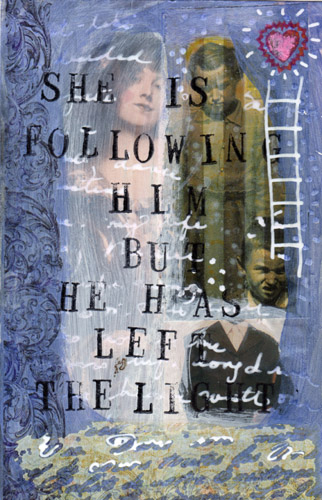 Lost Love, Altered Postcard, November 2007 Over the last month, in between preparing for workshops and submissions to galleries, I’ve been doing some research on artist/writer Nick Bantock. This December I hope to submit a postcard for a challenge paying tribute to his Griffin and Sabine trilogy: Griffin and Sabine: An Extraordinary Correspondence, Sabine’s Notebook and The Golden Mean. An extraordinary correspondence indeed the trilogy relays, through a series of postcards and letters (which we get to open and read!), the romance between Griffin Moss, an illustrator living in London, and Sabine Strohem, a stamp designer living in the fictional Sicmon Islands. Through magical means Sabine is somehow able to see into Griffin’s world. As readers we become voyeurs peering into the intimate correspondence between the two. One nagging question persists throughout the series … is Sabine real or is she a figment of Griffin’s imagination? When the two finally meet, this question is ours alone to decide as Bantock leaves readers to solve the mystery in their own imaginations. It’s a thrilling and visually compelling read as Bantock, a master collagist, leaves all kinds of clues and conundrums for us to uncover about his characters through his art.
With big boots to fill, I’ve been bent on “becoming” Nick Bantock. Like an actor who takes on a role by studying the life of the character she/he portrays, as an artist, I like to do the same. Through doing some research I’ve tried to get into the headspace of Bantock and his characters. I’ve gone through the trilogies as well as reviewing Bantock’s book Urgent 2nd Class, written for collage enthusiasts outlining his thoughts and approaches to art making. Technically, it’s not the most detailed step-by-step text but it gives great insight into a wide range of amazing collage techniques. The book is a must have for those interested in creating collages with all kinds of antique collectibles (ie. photos, postcards, stamps, books, banknotes and game boards). My favourite sections in the book deal with altering stamps/maps/engravings, playing with photocopies/rubber stamps and integrating drawings into artwork. For me, the beauty of Bantock’s collage style is how he so subtly and seamlessly weaves images and mediums; blending them so skilfully that they take on a life of their own.
After two weeks of reading, I needed to carry through with some action (!) so I laid out my modest collection of old postcards, stamps and rubber stamps on my studio table. I spent a few days looking them all over and eventually isolated a precious few I hoped Bantock himself might have chosen for his own postcard collage. As well as using these I thought I might be a bit gutsier and create my own antique-looking postcard. So far, I’ve thought working with the theme of the sea might be nice… maybe using an old photo of myself as a kid on a beach in Pakistan. In those days the beach was the greatest space of imagination for me: the endless Arabian Sea, the beautiful seashells and the sound of the ocean in them always managed to transport me to another world. I’ve got some old stamps from Pakistan I could use as well. I picked up a really neat sea shell stamp from my favourite local rubber stamp store Heather’s Stamping Haven. On Thursday afternoon while searching for images for a workshop I found a perfect pair of sandy feet that might look great as a postcard cover (eureka!) … so it looks like I’m ready to experiment! Now, I just hope I can get it done in time for December 1st! If nothing else it’s a great opportunity to peer into the visual soul of one of my favourite artists. See this link for information on the Griffin and Sabine postcard challenge.
You can buy antique postcards and stamps at local antique stores or fairs. If you’re in the Ontario area, Gadsden Promotions gives a great listing of vintage book/paper/postcard shows. If you’re a Nick Bantock fan, here’s a little something for you to check out. My good friend and creative soul Diane Salter, and her friends were so taken up by the Griffin and Sabine stories, they invented their own lovers, Parus and Alexandra, and created a postcard correspondence between the two (check Set 1 and Set 2). If you’re interested in other collage postcard artists “Signs in the Wind” by artist Lenore Tawney is excellent! Here’s a great link written by Clairan Ferrono to fill you in a bit about Tawney’s life and art.
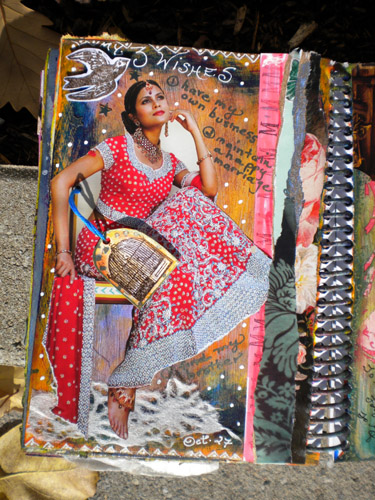 Three Wishes, Journal Page October 27 2009 1. Permanent Glue Stick (my favs UHU, Coccoina (thanks Kelly Kilmer!), Lepage)
2. White Glue (like Elmer’s)
3. Clear Glue (Glossy Accents is great for embellishments on glass)
4. Gel Matte Medium (for thick papers and light objects)
5. Matte or Glossy Scotch Tape (for me it’s 3M or nothing!)
6. Modge Podge
7. Spray Adhesive (always use in a well ventilated area)
8. Patterned Scrap booking tapes
9. Masking Tape (try drawing on this — learned that from Juliana Coles)
10. Dymo Embossed Tape
11. Duct Tape (Duck Brand from Michaels comes in amazing colours & patterns)
12. Aluminium Tape (try embossing tools on this)
13. Electrical Tape
14. Packing Tape (this is great for making transfers, too!)
15. Wire (great for tin)
16. Bee’s Wax
17. Needle & Thread (sew by hand or machine)
18. String (natural or synthetic)
19. Embroidery Thread
20. Fabric Pins
21. Fabric Tape (for fabric)
22. Ribbon/Lace
23. Velcro
24. Thin Double-Sided Tape (great for under transparencies)
25. Thick Double-Sided Tape (to add dimension)
26. Glue dots
27. Regular Office Staples (silver)
28. Coloured Staples
29. Paper clips
30. Decorative paper clips
31. Post-it-notes
32. Brads (multi- or metallic coloured)
33. Eyelets (multi- or metallic coloured)
34. Sticky Photo Corners
35. Band aids
36. Medical tape
37. Nails (on thick substrates like wood)
38. Push pins (on corkboard)
39. Jello Pudding (just kidding!)
Wow! I didn’t think I’d be able to come up with that many when I started. I got all these wonderful alternative gluing ideas from mixed media books and magazines as well as great instructors.
In collage, glue is the tie that binds. In fact you may already know that the word “collage” itself is derived from the French term “colle” which means “to glue”. Once you really get to experimenting with your collage and mixed media work, you may want to shake things up by sticking the occasional item down with something other than glue to add further variety and interest to your art.
Like pieces of paper or other embellishments you choose to create your art with, the things you use to affix your papers can add that extra oomph to your collage, whether it’s on paper, canvas, fabric, tin, glass or wood, making it more visually appealing and meaningful. In the above journal page example, as well as gluing my pieces on with permanent glue stick, I also attached a stamped birdcage on cardboard to the page with a brightly coloured piece of embroidery thread which hangs across the page; occasionally it slips out adding some charm and intrigue to my journal when it’s closed. In the top left corner, I used a thick bit of 3M double-sided tape to give a flying bird some dimension on my page so it appears raised. If archival considerations aren’t a major concern for you why not try to incorporate some of the more unorthodox gluing methods listed above. All, of course, with the exception of Jello Pudding. That you can save for dessert!!!
If you’ve used some inventive ways to “glue” your collage or mixed media pieces and would like to add to my “There Must Be 50 Ways… ” list, feel free to send me your ideas!
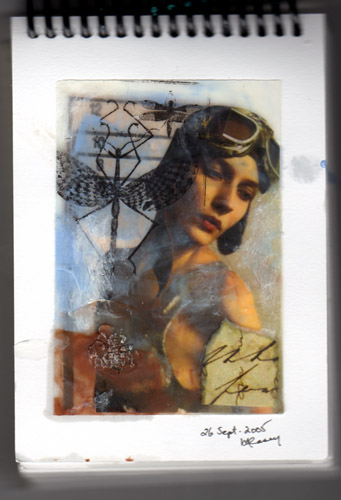 Mini Sketchbook, Fly Girl Test, Encaustic Collage September 2005 While working towards my visual arts degree, I dabbled in many different art forms – in university I learned much about the history of collage and mixed media art and artists, as well as experimenting with various methods related to it. I went from creating actual physical collages to virtual ones for the internet and CD-ROM. For a while virtual collaging was an exciting challenge, but in time because of its complexities, my fervour for it waned. As I continued to seek out the works of local and international artists working in this vein, I longed, once again, to create collages that were tangible… sensuous to the touch… full of rich, delicious surface textures… vibrant colours… ones which captured my artist spirit.
After reviewing my first few copies of Somerset Studio magazine back in 2005, I was convinced I should pursue more rigorous training in collage methods. In Somerset Studio the work of one particular artist, Claudine Hellmuth, caught my eye. I really enjoyed her humorous, witty, creative retro style creations. I was delighted to find out she had recently written a book of collage techniques, “Collage Discovery Workshop”, which I quickly scooped up from my local art store. After years of somewhat aimless experimentation, I was ready to pursue learning techniques which were tried, tested and true! Now, you should know, I’ve picked up many art technique books before – some of which are still gathering dust on my studio shelves, but this was not to be the fate of Claudine’s text.
I was impressed by the well-documented photographs and step-by-step instructions describing each project in “Collage Discovery Workshop”. I liked that the information regarding methods was laid out in a fun, easy-to-read manner. It included great resource references and a wonderful supply list that was often thoughtful to one’s budget. With such clear, concise instructions and beautifully photographed images of the projects it detailed, the book was begging to be read and tested! In a few days I eagerly reviewed the book and was bent on exploring several of the techniques discussed therein. In those days, I kept a small little mini sketch book to explore different methods from the book which I still have. I was so proud to fill up its pages with all the new things I learned. By the time I finished these exercises, I was quite confident about taking on larger projects with greater challenges. Here, I must say, the success rate of being able to re-produce Claudine’s techniques was high. The book exceeded my expectations and I enthusiastically recommend it along with its sister companion “Collage Discovery Workshop: Beyond the Unexpected” (just when we thought she must have run out ideas, Claudine bowled us over with more!). A few years ago, she began producing her own line of collage/mixed media products. She’s such an amazing artist and has been a great inspiration for me.
Even today, after discovering a number of wonderful books on the subject, I still highly recommend Claudine’s. I still use them to jog my memory when I go blank on methods. They have helped me to create encaustic collages, assemblages, works on canvas as well as canvas books. Suitable for the beginner or intermediate level artist, these texts present a series of exciting challenges from which artists can begin to construct their own visual collage/mixed media vocabulary. They’re definitely a series of collage adventures worth embarking on!
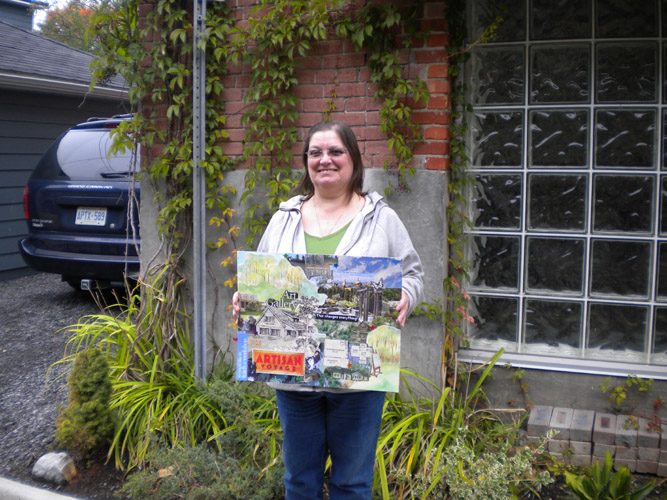 Susan Ashbrook with her Vision Board Summer 2010 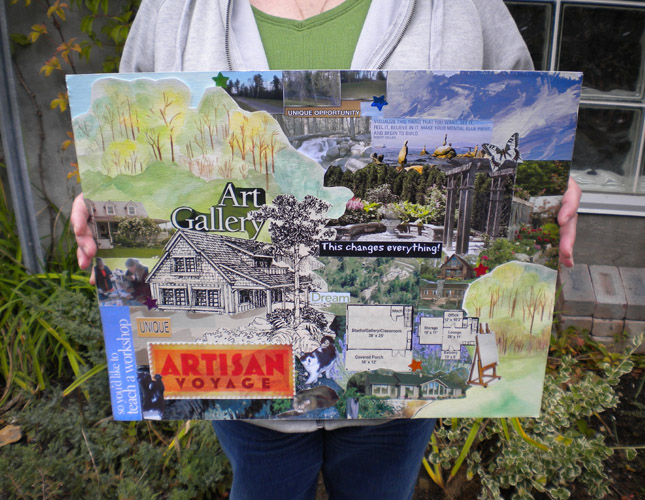 A Closer Look At Susan Ashbrook's Vision Board Summer 2010 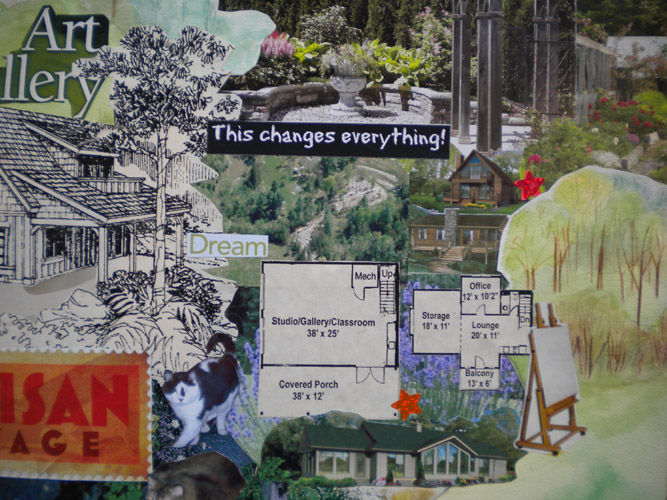 Susan Ashbrook's Vision Board with Cat, Plans & Texts Summer 2010 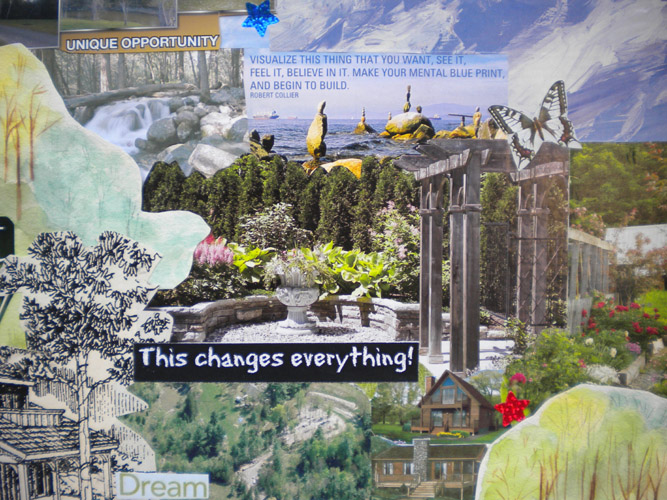 Susan Ashbrook's Vision Board with Butterfly & Stars Summer 2010 There’s nothing that makes me prouder than sharing the work of my students. This week I’m happy to spotlight another student from my summer 2010 “Visioning Your Life” workshop held at the Crichton Cultural Community Centre (CCCC). As you may recall, four enthusiastic souls gathered to collage their dreams into a vision board – a tangible touchstone they could draw inspiration from to make their dreams a reality.
Like many artists, Susan Ashbrook’s dream is of further expanding her art business. Although she already has a cozy workspace, Rosecliffe Studio, on the banks of the beautiful Ottawa River in Cumberland, Susan envisioned having a much larger one. In her dream studio she hopes to continue to practice her art, give classes and have the opportunity to host shows. Nestled within a peaceful community setting, her vision is one many artists can relate to. I love that in the early autumn of her life, Susan’s ambitions for her career are as strong as ever; I really admire her ability to dream BIG!
Susan’s passion for creating a vision board got her collecting materials well before the class. By the time it rolled around; she had dozens of pieces of magazines, flyers, her own artwork and other whimsical sources with which to compose her vision. The image of her dream studio was so clear in her mind’s eye that she even included architectural plans for it! Adding layers of inspirational words, phrases and a favourite quotation, she greatly enhanced the power of her vision board. I loved all the small details she included to personalize it further – making it her own space… children studying art outdoors, photos of her three cats, a fluttering butterfly, a secret garden and, my favourite, glittery star stickers! A thoroughly dynamic vision board, it was a space that really compelled me to travel through it to discover the many elements of her dreamscape. I truly hope she will find the means to make her dream studio a reality one day. And I know that she is working hard to make it so. In creating her vision board she is already one small step closer to achieving that goal.
Here’s what Susan had to say about the process:
Creating my vision board, in Michelle’s workshop, was a truly wonderful experience. I was able to take my dream from being ethereal wisps of contemplation to a physical, visual representation that made it real. It also helped me to refine and solidify my vision. When I had several pictures about a similar part of my dream, I had to think about which to choose, which helped me narrow the idea down to one concrete piece of information. The result is a piece of artwork that draws the viewer in and through it, as each image flows into the next.
Susan Ashbrook is Program Director of the CCCC. A versatile art professional, she teaches acrylic painting, mixed media art, colour theory and art business courses in the Ottawa, Ontario area. Having benefited from a number of her classes, I highly recommend them. It was great to guide Susan through this stage of her journey. Not so long ago she was responsible for sowing the seeds to help me achieve my own dream of starting an art business. Amazing vision board Susan! You go girl!
 Tribute to Michael Jackson, Journal Page March 8 2010 This is the first of the many small tips I hope will help inspire your collaging…
Many of us wait for that one special moment when the creative muse will strike us with her magic wand and voila! –we’ll suddenly be in the mood for creating the most beautiful, perfect piece of art work ever! For many of us this moment is totally non-existent! In fact, in our busy day-to-day lives, these moments are few and far between. What can we do to get us in the mood for creating? When I feel stuck and want to get into the groove of making art, I put on a selection of my favourite music. Known to reduce stress, aid relaxation, alleviate depression and even improve memory; music is also the perfect muse for motivating creativity. Nothing sparks my imagination like the sound of music.
Now to be more specific here, not any old music will do… the best are the pieces that have played a significant role in what I call the “soundtrack of my life”. This music has shaped me, helped me grow and been part of the emotionally compelling moments of my life. As a child in the 70’s, the music of Joni Mitchell, America, Cat Stevens, James Taylor, Janice Ian and Roberta Flack always stood out for me. Hearing these reflective, melancholy tunes help draw out the painful life lessons I have learned. Moving through my teens into young adulthood, the music of the 80’s brought energy and excitement into my life. Michael Jackson, Madonna, George Michael got me rocking – even today this music still has the ability to recapture the energy of my youth so I can channel it into my work. When I’m most afraid or apprehensive, for some reason, the musical rhythms of Michael Jackson’s “Rock with You” never fails to ignite a creative fire inside me. Then there’s the music that has shaped my consciousness – Jackson (again), Sting, Robbie Robertson, Madonna and Janet Jackson influenced my thinking in profound ways. Their Pop music philosophy got me thinking about the world around me, about social change, about religion and women’s roles in society. Hearing this music makes me want to challenge established boundaries and shape a new world consciousness through my art. Going beyond earthly boundaries musicians such as Enigma, Peter Gabriel and Vangelis have taken me to spaces devilish and divine… to the distant future and far reaches of outer space, and even further beyond the realm of my imagination. When I listen to this music, I feel as though I’m breaking free from the confines of terrestrial space into unknown or taboo territory. It helps my imagination roam and investigate my subject matter more freely. In short when I listen to the music from the different periods of my life I believe anything I choose to do is possible. Like a drug, it frees my emotions, opens my mind and unlocks my memory thus expanding my creative abilities.
So go out there and make a few special musical play lists for yourself: look to the sound track of your own life for inspiration. Remember to select music that brings insight, excitement, energy, a sense of fearlessness and wonder. You’ll find that once you lose yourself in the space that music creates for you, you’ll begin to feel like you’re indeed journeying into the space of your imagination and instead of being a hopeless task, making art will become a blast!
Here are 10 musical selections from my list of favs:
Michael Jackson: “Rock with You”
Janet Jackson: “Rhythm Nation”
Madonna: “Vogue”
Eartha Kitt: “C’est si Bon”
Robbie Robertson: “Somewhere Down the Crazy River”
Sting: “Moon Over Bourbon Street”
K-OS: “Crabbuckit”
Tammy Wynette/KLF: “Justified & Ancient”
Gwen Stefani: “Wind It Up”
Enigma: “Beyond the Invisible”
Does listening to music have a positive affect on your sense of creativity? If you have favourite music you’d like to share, I’d love to hear from you.
This week’s image (above) is a tribute to Michael Jackson. Note: The image of Michael was taken by photographer Claude Vanheye.
 My Love for Stories, Journal Page June 15 2010 Depending on the subject matter, the journal pages we create can be made for our eyes only or shared with others. Whether it’s done one-on-one or within a group, this can be a very rewarding experience. Recently, I re-connected with a special librarian who inspired one of the pages in my “Pieces of Me II” exhibition at the Ottawa Public Library. Over 40 years ago in this very same space, her magical voice made me fall in love with story telling.
The other week, on my way out of the children’s section of the library I glanced at the information desk. Why? Perhaps because when I put my exhibition up, I hoped in my heart that someone would recall the woman I spoke of in the “Why I love story telling” page. Too shy to ask anyone if they knew of the lady I remembered as “Mrs. Elechi”, I felt that too much time had elapsed since we last met. She would surely have retired ages ago. So you can imagine my surprise when my gaze caught her familiar face. Timidly I asked the librarian her name and to my amazement, the same golden voice answered with the warm, generous smile I remembered decades ago. The words, tripped out of my mouth… “Did you know you inspired one of my art works out there?!” Delighted, she immediately went out to view the piece with me… I hoped she would like it.
Drawing us in, the journal page ignited a discussion on the positive impacts of literacy on young lives; and the hopes that many librarians have that in every group of children they encounter that they can touch at least one life through reading. I let “Mrs. Elechi” know how it had transformed mine. Raised in an overly-protective family who had recently immigrated to Canada from Pakistan, I was unable to visit or make many friends outside the home. Reading allowed me to connect with Canada, as well as “travel” to places and discover things beyond my physical realm. Much like the internet today, it made me feel like a citizen of world. It was a practice I passed on to my younger siblings; our trips to the Ottawa Public library became an important family ritual. Through our discussion, I found out a few things about “Mrs. Elechi”, too. First, she was Italian and not Hungarian as my journal page noted her! Kind soul, she soothed my anxiety about this by assuring me many others had confused her accent for Hungarian. Also, that she still works at the library from time to time and reads to children (even her grandkids in the United States). After all these years I learned her full name: Grazia Lecci (and its proper spelling!).
It was wonderful to re-discover and share my page with Grazia. It made the act of creating and displaying my journal page about her more precious and complete. Meeting her again renewed my faith in the goodness that can be found in life. I was told later by her department head, Elizabeth Thornley, that our meeting that day was by great chance as Mrs. Lecci is posted at several library locations across the city and that her appearances at the main one are rare. I was so fortunate that fate had brought us together that day; it was the perfect ending to my exhibition. Echoing Mrs. Lecci’s sentiments Elizabeth reminded me how much her fellow librarians love to hear that their work touches the lives of those they encounter in a meaningful way. As an artist I feel this way, too. In Italian “Grazia” means “grace”; in Latin a variant of “grace” means “favour” or “blessing”… a blessing is certainly what Grazia Lecci was in my life along with countless other lives she transformed through her readings!
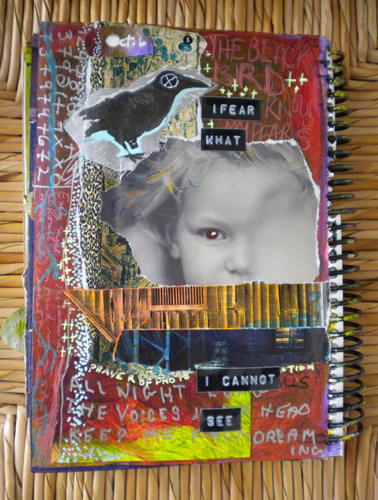 The Blackbird Knows My Fears, Journal Page October 6 2009 For some time now, I’ve been offering collage/mixed media journaling classes to no avail. For a while, it got me depressed, and then I asked myself: why aren’t people interested in visual journaling? A colleague suggested perhaps journaling seemed self-indulgent. After reviewing books and magazines on mixed media journaling, I could understand why. Feeling you have to spend much money on journaling supplies combined with devoting enormous amounts of time to crafting a “beautiful” journal along with time spent reflecting upon your life does seem rather indulgent.
But visual journaling doesn’t need to take tons of money or time. With a few basic supplies (see list below), the only other thing you need to get going is a series of journal topics or prompts. You can make these up yourself; look some up in creative writing or journaling books or find them on the internet (see list below). To get the ball rolling, I joined a daily online journaling class with Kelly Kilmer. There I discovered plenty of ideas for topics, techniques and the impetus to journal regularly. It wasn’t long before I began coming up with my own ideas for pages. Here I also learned I don’t need to create “beautiful” pages. The beauty of journaling is being to true to who you are and using creative techniques to compose your own unique visions rather than competing with others for the best looking pages. Not having to worry about making beautiful pages means you don’t need to take hours creating the perfect page. By choosing a few key images/colours/patterns and words, a page can be created in 20-30 minutes.
Why journal? Some of my fellow-journalers have dedicated their visual journals to their children, grandchildren, family members or friends. Getting on in age and, illnesses, sometimes are key factors in these decisions. I’m doing it for my younger siblings and family members because I think it’s a neat thing to know about your family’s roots. Besides leaving a legacy for loved ones, journals can be tools for self-discovery. Keeping a record of life events can make you feel your life and experiences count for something – are sacred, special even. Every day we are forced to hear about the achievements of newsmakers and stars but what about us ordinary folks? Who marks our passage of time, our achievements, trials and tribulations? Who better to record these but us?! In doing so, we can gain insight into ourselves and our life history. In this way journaling can be healing and empowering. If you’re a pessimistic person, it’s a great way to focus on the positive elements of life – reflecting upon the goodness in my life, brings hope.
Completing the cycle of visual journaling is sharing – something else I discovered through journaling classes. When I’ve gotten together to share my pages with others, I find the pages come more fully to life. Knowing others have experienced similar and sometimes extremely different life circumstances can create strong ties of friendship and community – it’s truly the most beautiful aspect of journaling for me. Stay tuned for more on this subject next week when I’ll share a wonderful example of this with you.
Basic Journaling Supplies List:
– Glue stick (UHU), transparent tape
– Scissors
– Stainless steel ruler (for tearing straight or rough lines)
– Small sketchbook with sturdy paper or used hard cover book with thick pages (90+lbs)
– 2 fine marker pens (.05 Micron) for drawing or writing (black and red)
– Images can be found in: used magazines, old photos, newspapers, old labels from food container/boxes, aluminium foil, gift or store packing tissue/wrapping paper, used ticket stubs and stamps, flyers, simple drawings or doodles, etc.
– A few coloured markers (Sharpies) for highlight things or colouring (Optional)
– Prompts from Books:
A Writer’s Book of Days by Judy Reeves
The Journal Junkies Workshop: Visual Ammunition for the Art Addict by Eric M. Scott and Dr. R. Modler
– Free On-line Prompts:
119 Journal Prompts for Your Journal Jar by Marelisa
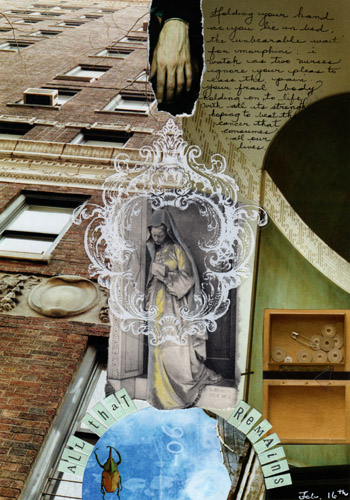 All that Remains, Journal Page February 16 2010 For the past month or so, illness and death have been on my mind. It began this summer when an uncle, almost 90, got scratched by his cat and suffered some long term health effects from the incident. While preparing for my fall show, I checked on him as frequently as I could as he dealt with the painful side effects of his medications. It was a relief to speak with him this week and find out he’s finally on the mend. No sooner had this happened when I received news that another elderly uncle of mine had just died from complications from a fall and liver disease. To add to this unhappy news, I discovered another close relative is battling a second bout of cancer and yet another good friend’s parent is suffering from the same disease. During these moments it’s hard to wonder if anything else matters… even art…
Feeling engulfed by the fragility of life and the nearness of death made me think back to my father’s passing of bone-related cancer (multiple myeloma) over 20 years ago. Given three months to live, he held on to life for seven miraculous years more. I was 18 when the disease took over his life and ours. All those years, which went by in a blur, were spent visiting him in the hospital every other day; living in limbo – never knowing for sure how long he would survive. When he was too ill to speak or heavily sedated all I could do was hold his hand to let him know I was there. When he was feeling well we had some good conversations about life and even death as well as the shenanigans that went on in the hospital. Some years he seemed constantly at death’s door; while other times, he went into periods of remission. He continually surprised us all, including his doctors and nurses, with his tenacity to live… even after falling once and breaking his hip, he survived the arduous surgery along with cancer. Dad worked as hard as any healthy person, nursing his broken hip back into the best form he could with lots of exercise. I still can’t get over the strength it must have taken to do that alone. I’m quite positive that the things that prolonged his life were the birth of my youngest sister along with his love for gardening. Later I learned, that the company of my husband and I – what I thought were futile visits, meant so much to him, too. Those memories of dad’s days in the hospital are sometimes all that seem to remain, but as unpleasant as they were at times, they also revealed a stronger and, sometimes, softer side of him I’d never seen before.
Summer is ended now and, as I look out my window and see the autumn leaves make their first appearance and the roses continuing to bloom despite the drastic drop in seasonal temperatures, I remember fall as the season we received dad’s death sentence. But I remember too that that didn’t stop his desire to live and to heal. And, so I hope that for my friends, relatives and you and yours who are undergoing similar painful experiences with loved ones that you too and they will find hope and courage in these hard times to survive despite the odds against them.
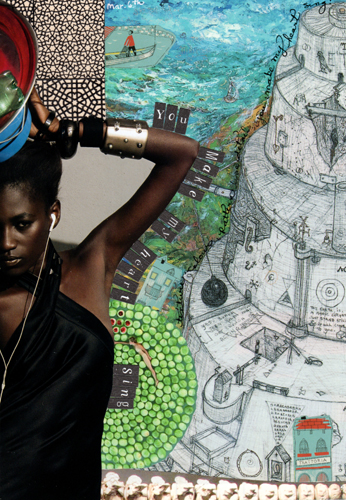 You Make My Heart Sing, Journal Page March 6 2010 For me, an artist’s work truly comes full circle when it engages people. And so, it was a great joy to see my work take this route at the opening of my “Pieces of Me II” exhibition held this past Thursday at the main branch of the Ottawa Public Library. There, a small, intimate group of family, friends, artist colleagues and library visitors gathered together to help me celebrate and launch my second solo exhibition. I’ve been a part of much larger receptions at group shows before where I never had to worry about rounding up visitors, so I was quite nervous about hosting my own opening. Initially, paranoid soul that I am, I had a sick feeling in the pit of my stomach that made me wonder if anyone would show up at all! But when the first visitor arrived, a steady stream of others followed filling the evening with vibrant conversation and good times. For those few hours, all the solitary hard work I put into the show seemed worthwhile as I shared conversations with my guests about life and the art of collage. Thanks to all those who made it out… despite homework, their own personal crises and hectic work/life schedules – I truly appreciated your support and learned much from what you had to say. Thanks too to those friends who took the time to congratulate me virtually as well as reviewing my website or show earlier – your support helped to make that day a very memorable one for me. Here I especially want to thank some of my friends from the Shabooya and A Life By Hand groups for remembering me. Finally, thanks to those anonymous library visitors who may have been too shy to say hello but still took the time to take in the show – I really appreciate your interest in my art!
For those of you who missed the opening, the show is up until September 30, 2010. I hope you will drop by, check out the exhibition and leave your thoughts. As a special incentive anyone who leaves comments about the show along with their email address/home address (at the library or on line) will be eligible for a draw of a free small print of one of my works from the exhibition. All the works from the show will be posted on my Portfolio website page on September 14, 2010.
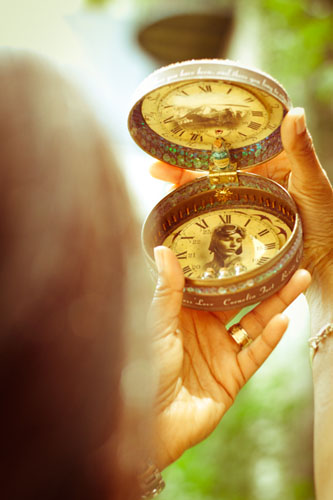 "Fly Girl" 2006 by Michelle Casey (Cornell-inspired assemblage) Book Review of Joan Sommer’s & Ascha Drake’s:
The Joseph Cornell Box: Found Objects, Magical Worlds (2006)
A Thoughtful Tribute to Joseph Cornell
It was by chance last week, while putting to use the gift card I got from my sister for my birthday that I stumbled across Joan Sommers’ and Ascha Drake’s The Joseph Cornell Box: Found Objects, Magical Worlds. Initially, what caught my eye was the really neat box it was housed in: its cover is a façade of one of Cornell’s boxes. To my delight upon removing the book I uncovered a real multi-shelved box inside with which to make my own Cornell-inspired art work — oh, I just knew my friend Olive, an equally ardent fan of his, would be so envious, of my latest find! I dashed off with it, delighted to add it to my modest stash of books on the great collage/assemblage artist. Sommers and Drake, two elementary school teachers, were inspired to write this book while teaching and exploring Cornell’s work with their own students. Addressing the reader as a fledging collage artist, the book includes a brief account of Cornell’s personal life, his connections to art history, his artistic practice and tales related to the subjects that drove his obsessions. It also contains a useful glossary of collage-related terms; a listing of Cornell’s work around the world and an excellent reading list. I loved the book’s easy-to-read style – I devoured it in a day! An especially attractive feature of the book is its cool design layout. Each page is carefully crafted in the manner the artist himself might have assembled it replete with: star charts, butterflies, birds, time pieces, buttons, scrabble letters, old fashioned labels and type-face, antique/vintage papers and photographs – symbols that familiarize students with the artist’s frame of mind and historical context. Memorable photos in the book include a glimpse of Cornell’s basement studio crammed with boxes as well as a memorable image of the late artist’s kitchen window taken by noted photographer Duane Michaels – an eerily fitting portrait. This book is great for the obsessive Cornell fan. It includes a list of his favourite foods as well as a New York City map detailing the artist’s favourite haunts. Highlighting the city as a kind of “classroom” for the self-taught Cornell is a strategy all aspiring artists can benefit from. After whetting our appetite with much insightful information, readers are given detailed instructions and creative tips on how to construct their own box assemblages. If this isn’t enough, as revealed earlier, the authors also include a box and materials for creating your own assemblage! I have built Cornell-inspired assemblages in the past and I must say this book really reignited my passion for making them. I highly recommend it for children/teens (age 10 and up) and adults interested in taking their collage projects to the next stage of assemblage or anyone interested in gaining some preliminary insight into Joseph Cornell.
|
|













